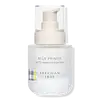What's inside
What's inside
 Key Ingredients
Key Ingredients

 Benefits
Benefits

 Concerns
Concerns

 Ingredients Side-by-side
Ingredients Side-by-side

Water
Skin ConditioningCaprae Lac
Skin ConditioningZinc Oxide 13%
Cosmetic ColorantColostrum
Skin ConditioningBifida Ferment Lysate
Skin ConditioningLactose
HumectantMilk Protein
Skin ConditioningAloe Barbadensis Leaf Juice
Skin ConditioningCaprylyl Glycol
EmollientCarthamus Tinctorius Oleosomes
EmollientChamomilla Recutita Flower Extract
MaskingCocos Nucifera Fruit Extract
EmollientCucumis Sativus Fruit Extract
EmollientSymphytum Officinale Leaf Extract
Skin ConditioningHoney
HumectantEryngium Maritimum Extract
TonicShea Butter Ethyl Esters
EmollientHydrolyzed Milk Protein
Skin ConditioningBentonite
AbsorbentButyloctyl Salicylate
Skin ConditioningCaprylhydroxamic Acid
Capryloyl Glycerin/Sebacic Acid Copolymer
Skin ConditioningCetearyl Alcohol
EmollientCitric Acid
BufferingCyclodextrin
AbsorbentDiheptyl Succinate
EmollientGlycerin
HumectantGlyceryl Stearate Citrate
EmollientGlyceryl Caprylate
EmollientHydrolyzed Wheat Protein/Pvp Crosspolymer
Propanediol
SolventSodium Gluconate
Skin ConditioningSodium Stearoyl Glutamate
CleansingTocopherol
AntioxidantWater, Caprae Lac, Zinc Oxide 13%, Colostrum, Bifida Ferment Lysate, Lactose, Milk Protein, Aloe Barbadensis Leaf Juice, Caprylyl Glycol, Carthamus Tinctorius Oleosomes, Chamomilla Recutita Flower Extract, Cocos Nucifera Fruit Extract, Cucumis Sativus Fruit Extract, Symphytum Officinale Leaf Extract, Honey, Eryngium Maritimum Extract, Shea Butter Ethyl Esters, Hydrolyzed Milk Protein, Bentonite, Butyloctyl Salicylate, Caprylhydroxamic Acid, Capryloyl Glycerin/Sebacic Acid Copolymer, Cetearyl Alcohol, Citric Acid, Cyclodextrin, Diheptyl Succinate, Glycerin, Glyceryl Stearate Citrate, Glyceryl Caprylate, Hydrolyzed Wheat Protein/Pvp Crosspolymer, Propanediol, Sodium Gluconate, Sodium Stearoyl Glutamate, Tocopherol
 Reviews
Reviews

Ingredients Explained
These ingredients are found in both products.
Ingredients higher up in an ingredient list are typically present in a larger amount.
Zinc Oxide is a mineral broad-spectrum UV filter; it is the broadest UVA and UVB reflector approved by the FDA. It also has skin protectant and skin soothing properties.
Zinc oxide is one of the most effective broad-spectrum UV filters. It protects against UVB, UVAII, and UVAI. In comparison to its counterpart titanium dioxide, zinc oxide provides uniform and extended UVA protection.
Another great benefit? This ingredient is highly photostable so it won't degrade easily under sunlight.
A common myth is that mineral UV filters are widely believed to primarily reflect UV light.
However, modern research shows titanium dioxide absorbs UV radiation like chemical filters (~95% absorption & 5% reflection).
Zinc oxide has great skin soothing properties so you'll likely find this in sunscreens formulated for sensitive skin or babies/children. It is unlikely to cause "eye sting" like other sunscreen ingredients.
Regulatory agencies consider zinc oxide to be non-toxic and safe. It has also been shown to not penetrate the skin.
Unfortunately, this ingredient does leave a visible white cast. This is why mineral sunscreens are often less cosmetically elegant than chemical or hybrid ones.
In cosmetics, zinc oxide can be found in both non-nano and nano-sized forms. The nano version is used to reduce white cast and improve the texture of sunscreen formulas.
There are ongoing concerns surrounding nano-zinc oxide's impact on marine ecosystems and whether it can be absorbed into skin.
Regarding marine ecosystems and coral reefs, there is no conclusive evidence that any form of zinc oxide (or any other sunscreen ingredients) will cause harm. The science is still developing but many consumers are keeping a close eye on this issue.
Please note, many destinations have reef-safety sunscreen rules. For instance, the U.S. Virgin Islands advises all visitors to use non-nano mineral sunscreens.
There has also been some stir about whether micronized or nano zinc oxide has potential photoxicity and absorption through the skin/lungs.
An in-vitro (done in a test tube or petri dish) study demonstrated micronized zinc oxide to have potential phototoxicity. There's no need to fret; the EU Commission's Scientific Committee on Consumer Safety has stated, "The relevance of these findings needs to be clarified by appropriate investigations in vivo." Or in other words, further studies done on living organisms are needed to prove this.
Current research shows zinc oxide nanoparticles do not penetrate intact or sunburned skin. They either remain on the surface or in the outermost layer of dead skin (stratum corneum).
Zinc oxide is one of only two classified mineral UV filters with titanium dioxide being the other one.
Fun fact: Zinc has been used throughout history as an ingredient in paint and medicine. An Indian text from 500BC is believed to list zinc oxide as a salve for open wound. The Ancient Greek physician Dioscorides has also mentioned the use of zinc as an ointment in 1AD.
Learn more about Zinc Oxide